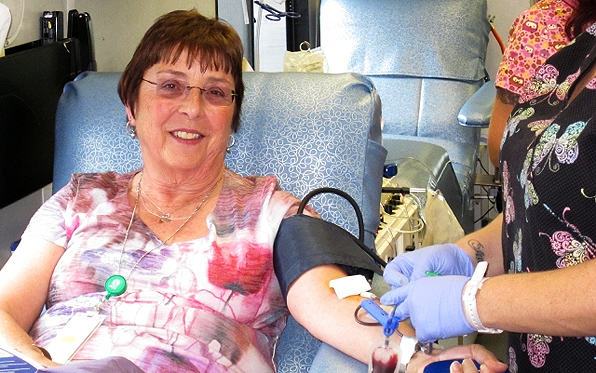 New material sorting equipment at County Library branches was one of the technology improvements recognized.
New material sorting equipment at County Library branches was one of the technology improvements recognized.
Cutting-edge county news websites. A mobile app that maps and tracks the status of the county’s 10,000 streetlights. Interactive, customer-friendly equipment at the County’s 33 branch libraries.
These are just a few of the visionary projects developed by county employees this fiscal year and recognized through the County’s IT Innovators award program. Last week, seven new winners were selected, growing to 15 the total number of IT Innovators picked this year. An overall Innovator of the Year is expected to be chosen this fall.
After the first and third quarters of each fiscal year, the county identifies individuals or teams from each working group who have developed outstanding information technology. Launched in late 2010, the program is part of a broader effort to increase county employees’ computer literacy. Winners earn recognition and a certificate. Any employee can submit a nomination by visiting the ITIQ Knowledge Center on InSite.
Here are this year’s IT Innovator winners, organized by working group:
Health & Human Services Agency:
1st Quarter
-Erik Nouvong of HHSA’s Public Administrator/Public Guardian Division worked to modernize critical mapping technology. Previously, employees in his division used Thomas Guides and websites such as Mapquest.com to navigate their routes in the field. Nouvong recognized the benefits that GPS and GIS technology could bring to the division’s field staff, helping map routes more quickly and efficiently. He also helped design an enhanced version of the GIS technology that brings up images of locations via computer, allowing employees to better plan their routes.
3rd Quarter
-Adrienne Perry of HHSA’s Office of Business Intelligence has, among other contributions, helped to centralize medical client records to better serve the public. She also worked to determine which verifications are needed from clients applying for eligibility services and helped improve HHSA’s emPowerSD.com website, which helps area residents find employment, child care assistance and other services.
Finance & General Government Group:
1st Quarter
-Arnold DeGuzman, Gretchen Sizer-Kecskes and Tegan Glasheen of the Communications Office led the effort to develop two new County websites: County News Center (CNC) and InSite. CNC is among the first sites of its kind nationwide, allowing the county to communicate directly with the general public in both crises and every day. It reaches internal and external audiences, providing news releases, videos, social media, traffic maps and more. InSite, meanwhile, is a modern, up-to-date internal portal for employees.
3rd Quarter
-Darin Craw of the Auditor & Controller’s office upgraded the way the Office of Revenue & Recovery compiles collection activity reports. Previously, employees manually put together and distributed the reports. With Craw’s help, the reports are now generated and distributed automatically, eliminating the possibility of error and delay while increasing employee access.
Land Use & Environment Group:
1st Quarter
-Mike Krosky and Victoria Loftis of the Department of Public Works developed a street maintenance mobile app for Blackberries that houses the locations and conditions of the 10,000 streetlights the County is responsible for maintaining. Workers can use the app to find the streetlights, check which need attention and then update their statuses.
3rd Quarter winners
-Yash Huilgol, a volunteer with the Department of Parks & Recreation and Eagle Scout, electronically mapped out Los Penasquitos Canyon Preserve. Using a smart phone, visitors can scan the preserve’s Quick Response (QR) system codes – the black and white square symbols -- displayed at mile markers to access detailed information about the 3,700 acre preserve. Huilgol also helped refurbish the markers.
-Michelle Price of the Department of Environmental Health oversaw a pioneering effort to integrate the county and the state’s systems for managing hazardous materials permitting. The effort followed the launch of Cal/EPA’s new reporting system.
Community Services Group:
1st Quarter winner
-Kathleen Honeysett of the County Library oversaw major technological improvements at the county’s 33 branches that transformed the way services are delivered to the public. Upgrades included the installation of self-serve check out equipment and copiers, material sorters and automated phone notifications. Honeysett made sure the improvements all worked well together.
3rd Quarter winner
-A team from the Registrar of Voters and Department of Human Resources updated the way the county manages staffing for seasonal election workers. Previously, supervisors in ROV would each hire and lay off election workers separately. The team led the creation of a centralized database where supervisors can quickly access information and re-hire experienced employees.
Public Safety Group:
1st Quarter winner
-Robert Barreras Jr. of the Office of Emergency Services led an effort to improve the County’s emergency website. During the 2007 wildfires, high traffic on the site overwhelmed its servers, delaying and at times dropping access entirely. The server capacities can now adjust based on demand and staff can easily update the content or distribute evacuation instructions and other information through user subscriptions. The website also combines what were three different sites related to emergency services: preparedness, response and recovery.
3rd Quarter winners
-Sheriff’s Lt. Jose Sanchez helped lead a successful effort to reduce high speed-related on-duty collisions within his department. Called The Patrol Speed and Safe Driving Initiative, Sanchez led the effort to capture a snapshot of speeding incidents over a one month period. As a result of the initiative, incidents involving patrol cars moving over 90 mph dropped by 65% and incidents involving patrol cars going more than 80% over the speed limit decreased 35%.
-Elainerose Lontoc of the Probation Department presented the findings of a study looking at how to improve her department’s case management system. Working with a governance committee, she recommended that the County focus on bettering the current system, which tracks all offenders, rather than procuring a new one.




